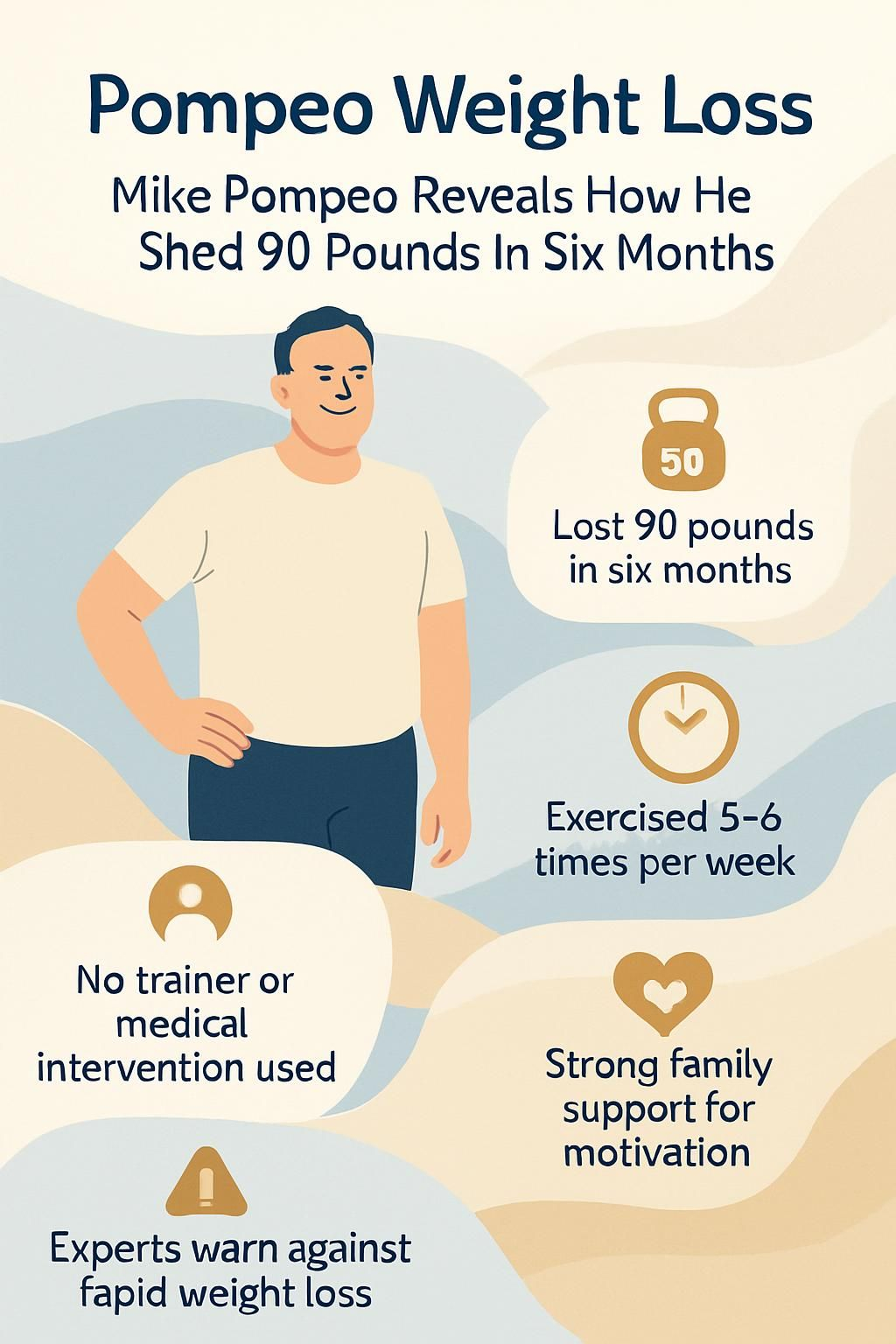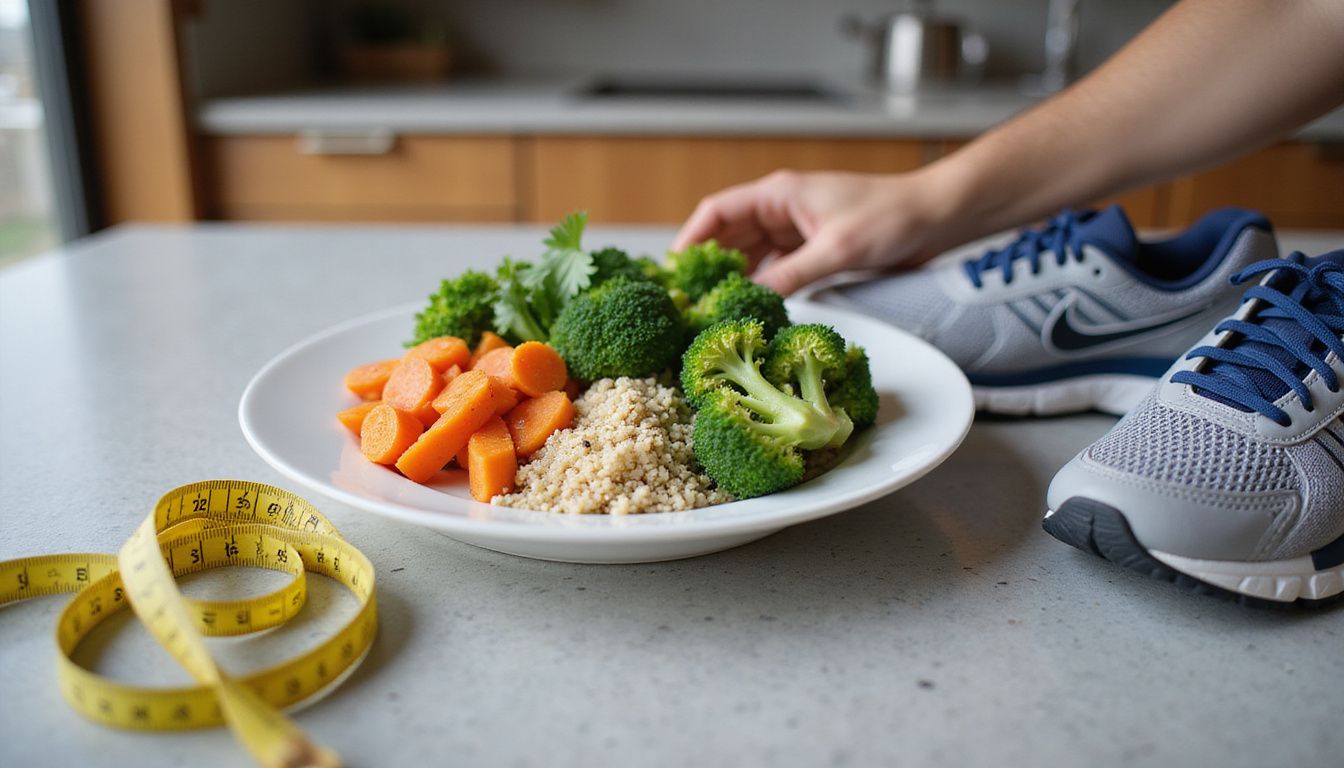Pompeo Weight Loss: Mike Pompeo Reveals How He Shed 90 Pounds In Six Months
Our Nutrition Assistant AI Suite will transform your body. You will lose fat, get toned, and build muscle. Gain confidence and optimal health.
If losing weight and keeping it off feels hard, you are in good company. The Mike Pompeo weight loss story drew attention after the former Secretary of State said he lost 90 pounds in six months. His account highlights basic steps that many people can use.
Mike Pompeo says he lost the weight through simple diet changes and steady exercise, without extreme shortcuts or supplements. Below, you will see what he adjusted, why it may have worked, and how to apply similar steps at home. Real change is possible with small actions done often.
Key Takeaways
- Mike Pompeo reports losing 90 pounds in six months in 2022 by cutting carbs, trimming portions, and exercising five to six times per week.
- His plan used home workouts with dumbbells and an elliptical, and he did not work with a trainer or use medical procedures, according to The Kansas City Star.
- Strong support from his wife, Susan Pompeo, helped him stay motivated and accountable.
- Experts, including coaches and registered dietitians, warn that losing about 15 pounds per month can be risky. They advise slower, sustainable progress for safety and long-term success.[1][2]
- Pompeo suggests keeping health as a core goal, tracking progress, avoiding quick fixes, and building discipline through daily habits.

Who Is Mike Pompeo and What Was His Weight Journey?

Mike Pompeo, former United States Secretary of State and past director of the CIA, received public attention for a dramatic weight change. His six-month claim of losing 90 pounds sparked interest in personal health, discipline, and accountability.
What Are Mike Pompeo’s Early Life and Career Highlights?
Born in Orange, California, Pompeo moved to the Midwest with his family and later attended the United States Military Academy at West Point. He graduated first in his class in 1986 and served as an Army officer until 1991.
After earning a law degree from Harvard, he co-founded Thayer Aerospace near Wichita, Kansas. Voters elected him to Congress in 2010 to represent Kansas’s Fourth District. President Donald Trump selected him to lead the CIA, then appointed him United States Secretary of State during the first presidency of Donald Trump. These high-profile roles required frequent travel across time zones and brought public scrutiny, including talk about a possible presidential run in 2024.
What Weight and Health Challenges Did Mike Pompeo Face?
Before his change in 2021, Pompeo described habits that fueled steady weight gain. Frequent travel and large, carb-heavy meals made it hard to manage calories and activity.
He enjoyed pumpkin pancakes at IHOP, bread, and rich dinners, which drove intake up. At age 58, he said his energy fell, and his clothes fit tighter. Photos showed his weight increasing over time, a pattern many busy professionals recognize.
Demanding jobs, long flights, and irregular schedules can disrupt healthy eating and workouts. Noticing warning signs can become a turning point. For many people, that first wake-up call is the scale or a tired look in the mirror.
Starting the Weight Loss Journey
Pompeo reports losing 90 lbs in just 6 months. His story shows how a simple plan and steady habits can add up.
What Motivated Mike Pompeo to Change His Lifestyle?
Health concerns pushed him to act. After years of service in Congress and travel across the globe as Secretary of State, he felt the toll of extra weight on his well-being and family life.
Pompeo said the goal was not public image. It was health. That focus often helps the change last, because the reason is deeply personal and clear.
“The truth is, I wanted to be healthier for myself and my family.”
Choosing a personal commitment, not a flashy fad, builds a better base for change.
How Did Mike Pompeo Overcome Initial Weight Loss Obstacles?
Early on, he faced strong food habits and large portions. He swapped high-calorie choices for lighter meals, like egg whites and turkey bacon at breakfast. He also set up a home gym with dumbbells and an elliptical machine. That cut travel time and excuses.
Without a trainer or dietitian, he leaned on routine, portion control, and simple rules. Exercise sessions lasted about 30 minutes. He aimed for five or six workouts each week. This approach fit around meetings and travel during and after his government service, including his time in the First presidency of Donald Trump.
Starting small and repeating the plan helped him move past the first few hard weeks.
Mike Pompeo’s 90-Pound Weight Loss Strategy
In interviews with The Kansas City Star, Pompeo outlined the approach he says helped him lose 90 pounds. Below are practical steps you can adapt to your life.
What Dietary Changes Did Mike Pompeo Make?
Food choices drive weight trends. He focused on fewer calories, higher quality meals, and smaller portions.
- Cut back on carbs like pancakes, bread, and pasta to reduce total calories.
- Build meals around protein, for example, egg whites, turkey bacon, lean poultry, fish, tofu, or beans.
- Reduce portion sizes at each meal. Smaller plates help many people eat less.
- Create a basic meal plan with your doctor or a registered dietitian if you need guidance.
- Choose mostly unprocessed foods, such as vegetables, fruits, whole grains, and nuts, to improve fullness.
- Track intake in a journal or app to spot patterns and stay honest.
- Repeat these steps daily. Consistency matters more than perfection.
How Did Reducing Carbs and Mindful Eating Help?
Lowering carbs can reduce hunger and calorie intake for some people. Pompeo leaned on protein and vegetables, then limited bread, pasta, and sweets. Research suggests that reducing refined carbohydrates may support fat loss and steadier energy for many adults.[2]
Mindful eating, which means slowing down and noticing hunger and fullness, helps prevent overeating. Chew well, set your fork down between bites, and pause when you feel satisfied. If you manage meals at home, it becomes easier to keep portions in check. For safety, talk with a healthcare professional before starting any restrictive plan, especially if you have diabetes or take medications.
What Fitness Routines Did He Follow for Weight Training and Cardio?
Exercise supported his diet changes. He used simple tools and short sessions.
- Set up a home gym with dumbbells, an elliptical machine, or a treadmill to make workouts more convenient.
- Schedule five to six sessions per week to build a routine you can keep.
- Keep most workouts around 30 minutes. Short sessions count if you repeat them.
- Lift dumbbells to build muscle, which helps your body burn more calories at rest.
- Use cardio like the elliptical or treadmill to strengthen your heart and increase daily burn.
- Skip all-or-nothing thinking. No trainer is required if you can stay consistent and safe.
- Pick a time you can protect most days, such as early morning or right after work.
- Rotate activities to avoid boredom and reduce overuse injuries.
- Pair workouts with a simple warm-up and cool-down to support recovery.
How Did Mike Pompeo Maintain Discipline Throughout?
Discipline, not novelty, held the plan together. He invested in a home gym, set a weekly schedule, and stuck with it. Mixing cardio and weights kept it fresh.
He says he avoided shortcuts like surgery or extreme plans. Instead, he relied on structure and support at home. On tough days, small wins, such as checking off a workout or cooking a balanced dinner, kept the momentum going.
Family Support in Mike Pompeo’s Weight Loss
Support creates a safety net. It can steady you when motivation dips.
What Role Did Susan Pompeo Play in His Success?
Susan Pompeo offered encouragement and steady reminders about the goal. Emotional support made it easier to keep promises on busy or stressful days.
If you are starting a plan, a partner or close friend can help you stick with routines. A quick check-in or shared grocery list can nudge you back on track.
How Did Family Accountability Influence the Process?
Accountability turned healthy choices into shared habits. Family meals became a time to practice portion control and pick better options.
Regular updates and honest conversations about progress can strengthen your commitment. Celebrating small wins builds confidence and keeps the plan moving forward.
Separating Fact from Fiction in Weight Loss
Shortcuts often sound exciting, but many fail the test of time.
What Are the Common Myths About Weight Loss Shortcuts?
One myth says you can only lose major weight with surgery or expensive help. Pompeo’s account, where he “started exercising” and changed his diet to lose 90 pounds in six months, raised debate among experts. Some professionals are cautious about such fast results without published medical details.
Miracle pills and crash diets promise speed, not stability. Most people regain weight if the plan is too strict or vague. Practical routines, paired with balanced meals, tend to work better over months and years.
Why Are Sustainable Lifestyle Changes Important?
Health agencies suggest losing about 1 to 2 pounds per week for most adults.[1] Faster loss can increase the risk of fatigue, muscle loss, gallstones, and a slower metabolism.
Steady changes help you keep the weight off. Balanced meals and regular exercise become part of daily life, not a temporary push. That is the path that protects health and fits real schedules, including travel and long workdays.
Lessons from Mike Pompeo’s Weight Loss Experience
Big goals become possible when you break them into small, repeatable steps.
How Can You Set Achievable Weight Loss Goals?
Clear goals make progress easier to track. Use simple, measurable targets and adjust as you learn what works.
- Aim to lose about 1 to 2 pounds per week, which matches common medical guidance.[1]
- Record a baseline with weight, waist size, or photos, then check weekly trends.
- Break the big goal into monthly milestones and plan the first few weeks in detail.
- Focus on daily actions, like cooking at home and walking more, not only the number on the scale.
- Reward milestones with non-food treats, for example, new workout gear or a day trip.
- Revise goals if your body needs it. Flexibility beats burnout.
- Protect your routines. Consistency turns behavior into habit.
Learning how others solved problems can spark ideas for your own plan.
What Are Tips for Staying Committed to Health?
Commitment grows when the plan is simple and visible. A few guardrails help you stay steady.
- Build a weekly workout rhythm. Aim for at least 30 minutes on most days, mixing cardio and strength training.
- Ask a friend or family member to check in. Share quick updates to stay accountable.
- Prioritize health markers like energy, sleep, and strength. These often improve before the scale moves.
- Eat mindfully and watch portions. Slow down, and stop when you feel comfortably full.
- Track meals and workouts in a journal or app. Data reveals patterns you can fix.
- Celebrate small wins, like climbing stairs without getting winded, to boost motivation.
- Keep healthy snacks visible, such as fruit, yogurt, or nuts, to cut impulse eating.
- Adapt the plan during busy weeks. Shorten sessions rather than skipping them.
For example, you could block ten minutes after lunch for a brisk walk. It is short, repeatable, and easy to protect.
How Can Busy People Manage Fitness Effectively?
Time is tight, but small slots add up. Remove barriers that slow you down.
- Use short sessions, about 30 minutes, five to six times each week.
- Build a simple home setup, like dumbbells and an elliptical, to save time.
- Follow self-guided routines so you are not tied to class times.
- Choose activities you enjoy, such as walking, cycling, or bodyweight circuits.
- Track progress to see trends, which keeps you motivated.
- Involve family for natural accountability and shared goals.
- Stack movement into your day. Take stairs, walk during calls, or stretch while watching TV.
- Lay out clothes and gear the night before.
- Put workouts on your calendar as you would any meeting.
- Use reputable apps or guides that focus on quick, safe home routines.
Expert Opinions on Rapid Weight Loss
Health professionals caution against very fast loss. Safety and long-term results matter more than speed.
What Do Health Experts Say About Losing Weight Quickly?
Losing 90 pounds in six months equals about 15 pounds per month. Coaches and dietitians say that pace is not typical for many adults, especially at age 58. Many medical sources recommend 1 to 2 pounds per week for most people to reduce risks like muscle loss, gallstones, and metabolic slowdown.[1][2]
Your body needs time to adapt to a calorie deficit, which is the gap between what you eat and what you burn. Aggressive cuts can leave you tired and hungry. Experts favor steady progress because it is easier to maintain.
What Recommendations Do Fitness Professionals Give?
Pros aim for safe, repeatable steps that fit daily life. Here is a quick checklist.
- Set realistic targets, about 1 to 2 pounds per week, based on your health status.
- Track food daily. Self-monitoring increases awareness and reduces guesswork.
- Eat mostly whole foods, such as vegetables, fruits, legumes, lean proteins, and healthy fats.
- Balance cardio with strength training. Both support fat loss and muscle retention.
- Be consistent. Short sessions work if you repeat them across the week.
- Drink water instead of sugary beverages to support energy and appetite control.
- Ask a certified trainer or medical professional for personalized advice if you have health conditions.
- Avoid strict crash diets or extreme calorie cuts. They often backfire.
- Include rest days to recover and prevent injury.
- Be transparent about your methods if you share results publicly. Clear context helps others learn.
Mike Pompeo’s Advice for Starting Weight Loss
Pompeo’s tips focus on simple, repeatable actions that fit into busy routines.
What Motivational Tips Does Mike Pompeo Offer?
Staying motivated matters as much as the plan. Use these points to keep going.
- Make personal health your top reason. A strong “why” supports daily choices.
- Own your decisions. You control your meals, schedule, and effort.
- Skip shortcuts. Build steady habits for results that last, as he reported during his six-month loss.
- Practice daily discipline in eating and exercise. Show up, even on average days.
- Lean on loved ones for support and accountability, like he did with Susan Pompeo.
- Track progress with a scale, tape measure, or photos. Visible change fuels effort.
- Set realistic milestones. Avoid goals that require unsustainable behaviors.
- Celebrate small wins, such as better sleep or looser clothes, to stay positive.
How Can You Build Consistent Healthy Routines?
Consistency comes from planning your environment and your time. Make the healthier choice the easier choice.
- Schedule five or six workouts per week, even if some are short.
- Create a workout corner at home to reduce friction.
- Stock your kitchen with foods you plan to eat, not just foods you wish you liked.
- Share goals with family or friends. Accountability helps on low-energy days.
- Track activity and meals daily. Seeing streaks can keep you engaged.
- Plan breakfasts and lunches ahead to avoid impulse eating.
- Protect sleep. Quality rest supports appetite control and recovery.[2]
- Reward steady effort, for example, new shoes after a month of workouts.
- Limit screen time at night to improve sleep and reduce late snacking.
- Treat setbacks as data. Adjust the plan, then move forward.
Conclusion
Mike Pompeo’s weight loss story highlights the power of simple food choices, regular exercise, and strong support. He reports losing 90 pounds in six months through consistency, home workouts, and portion control. While inspiring, most people do better with slower, safer progress that matches medical guidance.[1]
Set clear goals, build repeatable habits, and use help from family or a trusted professional. If you have health conditions, speak with your doctor before making big changes. With patience and a steady plan, healthier routines can stick.
Sources: Centers for Disease Control and Prevention, Healthy Weight Basics; American College of Sports Medicine, Physical Activity Guidelines; The Kansas City Star, 2022 interview coverage of Mike Pompeo’s reported weight loss.
FAQs
1. How did Mike Pompeo lose 90 pounds in six months?
Mike Pompeo achieved his weight loss through a structured diet, regular physical activity, and consistent lifestyle changes. He focused on portion control and avoided processed foods. Reports indicate he exercised daily and monitored his calorie intake. These strategies align with recommendations from health organizations for sustainable weight loss.
2. What specific foods did Pompeo include or avoid during his weight loss journey?
Pompeo prioritized lean proteins, vegetables, and whole grains while limiting sugary drinks and high-calorie snacks. He reduced his intake of fried foods and processed meals. This approach matches evidence-based dietary guidelines for effective weight management.
3. Did Mike Pompeo use any supplements or medications to aid his weight loss?
There is no credible report that Pompeo relied on supplements or prescription drugs for his transformation. His progress resulted from disciplined eating habits and regular exercise routines. Health experts often recommend lifestyle modifications as the safest path for long-term results.
4. What advice does Pompeo offer others seeking similar results?
Pompeo emphasizes the importance of consistency and personal motivation. He suggests setting realistic goals and tracking progress over time. His experience highlights how gradual adjustments in daily habits can lead to significant health improvements.
Summary:
Mike Pompeo’s 90-pound weight loss resulted from disciplined eating, regular exercise, and a focus on healthy habits rather than quick fixes or medication. His approach reflects widely accepted medical advice for sustainable results supported by data from nutrition research and health authorities.







